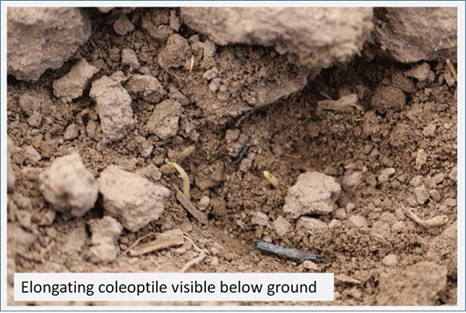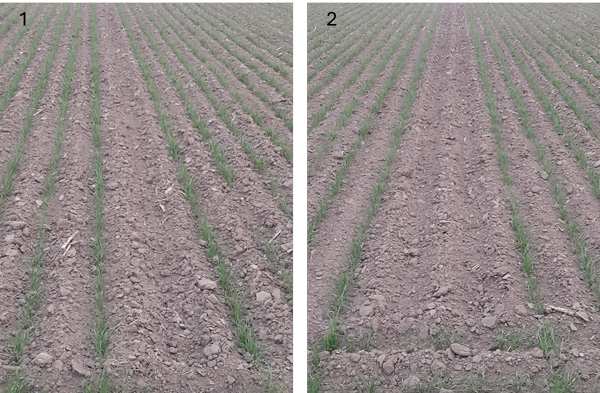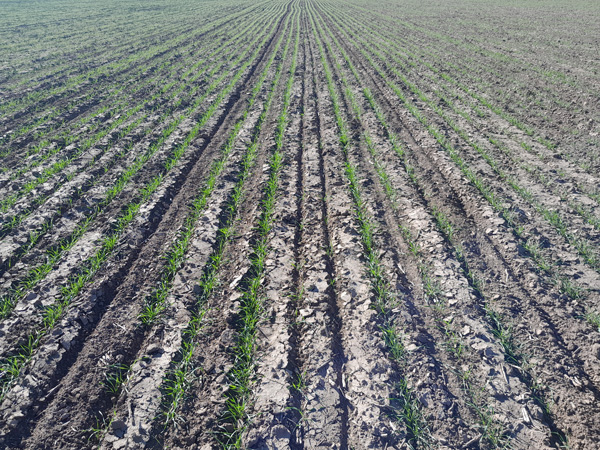As wheat growers evaluate their wheat stand, some may consider replanting fields yet this fall. There are many potential causes of poor or uneven emergence or stand establishment, and they may differ from field to field. The fall of 2024 has been challenging for winter wheat establishment in Kansas and in the US Southern Great Plains. Some regions received precipitation in early September and growers who took advantage of this moisture generally attained good stand establishment. However, it has been extremely dry since, and these stands may be suffering, so these growers are now likely concerned with the drought conditions that followed planting as the wheat plants start to show symptoms of drought stress.
For growers that did not plant around precipitation events – perhaps because it was still too early for their region – fields may be showing some scattered emergence as seeds may have reached moisture in parts of the field but not in other parts. These growers may be considering the replant their crop. If dry soils are the cause of the problem, replanting will not bring many benefits unless the seed has partially germinated and perished before emerging. It is very important to dig into the soil and evaluate the seed to determine the cause of poor emergence. Wheat seeds may still be germinating and emergence may occur in the next few days, depending on temperatures. Thus, if seed are still hard and viable, or if germination started to occur recently and there is a very short coleoptile emerging from the seed (Figure 1), the best advice is to leave the field alone.

Figure 1. Wheat seed with elongating coleoptile visible below ground. Photo by Romulo Lollato, K-State Research and Extension.
When deciding whether to replant wheat fields, it is helpful to consider these factors: stand uniformity, percent stand compared to the target stand, replanting date, weed control, and insurance cutoff date.
Stand uniformity
In fields in which topsoil moisture was variable at the time of planting, some seeds might have germinated and emerged where soil moisture was sufficient, while others might have started the germination process but perished where soil moisture was too low, while others might not have started the germination process at all. This will cause poor and scattered wheat emergence across the field, with sometimes recognizable field patterns associated with the moisture distribution in the soil. In this case, stands might be relatively uniform in poorer-drained areas where moisture might have accumulated but non-existent in better-drained areas, leading to high within-field variability. In this case, growers should check for seed viability in areas with poor emergence. If the seed is still viable, then the field should be left alone. If the seeds imbibed water and started to germinate but perished, then these portions of the field should have top priority for replanting. If a stand is sparse in areas that already emerged, producers should also consider replanting these areas with lower seeding rates to bring final population closer to the desired stand, as discussed below.
Percent stand compared to the goal
In areas with suboptimal and thinner stands than desired, counting the number of emerged plants per row foot and comparing the observed stand to target populations (Table 1) is a good place to start.
The target number of plants per row foot (Table 1) is influenced by seeding rate, seed size, and row spacing, considering 80% emergence. If seed size is unknown, 14,000 to 16,000 seeds per pound can be used for most wheat varieties in Kansas, except those with rather large or small kernels (note: commercial range in seed size may be as variable as 8,000 to 22,000 seeds per pound). To determine the average number of plants per foot of row, several random plant counts across the field should be taken, given a more or less uniform emergence throughout the field. If the average number of plants is about 50 percent or more of normal and the stand is evenly distributed, the recommendation is to keep the stand. Wheat’s tillering ability can greatly compensate for poor stand provided soil fertility is adequate, the weather is favorable, and the plants are few but fairly uniformly distributed (large gaps will likely not be compensated). With less than 40 percent of a normal stand, the recommendation is to replant the field. If possible, replanting should be done at a 45-degree angle to the original stand to minimize damage to the existing stand.
Table 1. Target plants per row foot (80% emergence) based on seeding rate, seed size, and row spacing.
|
|
|
Row spacing (inches) |
||||
|
|
|
6 |
7.5 |
8 |
10 |
12 |
|
Seeding rate |
Seed size |
Target plants/row foot (80% emergence) |
||||
|
45 |
12,000 |
5 |
6 |
7 |
8 |
10 |
|
14,000 |
6 |
7 |
8 |
10 |
12 |
|
|
16,000 |
7 |
8 |
9 |
11 |
13 |
|
|
18,000 |
7 |
9 |
10 |
12 |
15 |
|
|
60 |
12,000 |
7 |
8 |
9 |
11 |
13 |
|
14,000 |
8 |
10 |
10 |
13 |
15 |
|
|
16,000 |
9 |
11 |
12 |
15 |
18 |
|
|
18,000 |
10 |
12 |
13 |
17 |
20 |
|
|
75 |
12,000 |
8 |
10 |
11 |
14 |
17 |
|
14,000 |
10 |
12 |
13 |
16 |
19 |
|
|
16,000 |
11 |
14 |
15 |
18 |
22 |
|
|
18,000 |
12 |
15 |
17 |
21 |
25 |
|
|
90 |
12,000 |
10 |
12 |
13 |
17 |
20 |
|
14,000 |
12 |
14 |
15 |
19 |
23 |
|
|
16,000 |
13 |
17 |
18 |
22 |
26 |
|
|
18,000 |
15 |
19 |
20 |
25 |
30 |
|
|
120 |
12,000 |
13 |
17 |
18 |
22 |
26 |
|
14,000 |
15 |
19 |
21 |
26 |
31 |
|
|
16,000 |
18 |
22 |
24 |
29 |
35 |
|
|
18,000 |
20 |
25 |
26 |
33 |
40 |
|
Mechanical Seeding Issues
Occasionally, seeding issues arise with mechanical equipment failure that could result in the seed not being properly placed in the furrow. This could be the result of a plugged opener or a hole in the seed tube. These skips are obvious from a long-distance away, look bad, and depending on the number of plugged openers could significantly reduce yield and be less competitive against weeds. The amount of yield loss will depend on environment, variety, seeding rate, and width of skip. A dryland study comparing row spacing in western NE found 7.5- and 10-inch row spacing consistently had greater yield than 15 or 20” row spacing (~60% yield of narrow row) (Sciencia et al., 2023). If there is a single row skip the neighboring rows can partially compensate for the skip, but if there are multiple row skips than the neighboring rows will not be able to compensate.
Calculating potential yield and gross profit loss:
- (Number of openers plugged/Total openers) x Yield potential (bu/acre) x Estimated yield loss (%) = Yield loss (bu/acre)
- Yield loss x Price ($/bu) = Gross profit loss ($/acre)
Example 1: 1 plugged row on a 30-foot drill with 10” row spacing, 60 bu/acre yield goal, 40% yield loss, and July 2025 futures cash price of $5.55/bu (Figure 2-left):
- (1/36) x 60 x .4 = 0.67 bu/acre
- 0.67 x 5.55 = $3.70/acre
Example 2: 2 plugged adjacent rows on a 30-foot drill with 10” row spacing, 60 bu/acre yield goal, 100% yield loss, and July 2025 futures cash price of $5.55/bu (Figure 2-right):
- (2/36) x 60 x 1 = 3.33 bu/acre
- 3.33 x 5.55 = $18.48/acre

Figure 2. Example 1 photo showing a single row skip (left photo). Example 2 photo showing two adjacent row skips (right photo). Photos by John Holman, K-State Research and Extension.
Example 3: 1 plugged row and 1 outside row partially plugged on a 30-foot drill with 10” row spacing, 60 bu/acre yield goal, 40% yield loss across, and July 2025 futures cash price of $5.55/bu (Figure 3):
- (2/36) x 60 x .4 = 1.33 bu/acre
- 1.33 bushel/acre x $5.55/bushel = $7.40/acre

Figure 3. Photo for Example 3 scenario. Photo by John Holman, K-State Research and Extension.
In the examples above, if one row is not planted correctly (Example 1), the yield and gross profit loss would be negligible. However, if there are two or more adjacent rows that had a skip (Example 2), then it would most likely be best to replant that area. Reseeding over an area of established plants can cause damage to the established seedlings. Reseeding with a 30-foot drill for a 2-foot skip is also not advisable. It would be best to find a narrower (10’) double disk drill if it is estimated that the yield loss is significant.
In Example 3, if a 10’ drill was used, it would cover both problem rows and two passes the 30-foot drill made with one pass (due to placement of the bad rows). In this case, it might pay to replant this strip across the field. In Example 3, only 10’ of every 60’ or 1/6th of the field would need to be replanted. If using a 10’ drill, the replanting would cost approximately 1/6 x (cost of seeding ($17) + seed cost per acre ($10)) or $4.50/acre. In Example 3, the estimated net return per acre from reseeding could be $3.00/acre. However, reseeding will cause some damage to the established plants, and this needs to be considered. In most cases, the skips will look bad but have little negative impact, and the best thing to do is not replant. However, with less crop competition, plan on a good weed management program.
Replanting date and seeding rate
As of late October, most of the state has passed the optimum sowing date, with maybe the exception of far south-central or southeast Kansas. For portions of the field with no established stand (the entire stand will need to be replanted), producers should plan to increase their seeding rates by 10-15% every week past the optimum sowing date.
In areas where a partial stand was achieved but for a total of about 50% stand, or parts of the field that did not emerge evenly, or where the seedlings have perished after planting, producers should make the decision about replanting immediately to avoid further compromising the yield potential.
In portions of the field where the stand is below optimum, producers can cross-drill at the rate of 30-40 pounds per acre in western Kansas and 40-60 pounds per acre in central and eastern Kansas, using a double-disc opener drill, if at all possible, to minimize damage to the existing stand. If the replanting is done in November or later, increase the seeding rates to 60-75 pounds per acre in western Kansas and 75-90 pounds per acre in central Kansas. If stands are less than 30 percent of normal, increase these seeding rates by 20-30 pounds per acre. The higher seeding rates are needed because the cool soil temperatures encountered by late-planted wheat will likely slow emergence, favor seedling diseases, and reduce the potential for fall tillering. Using a fungicide seed treatment can reduce the potential for seedling disease and help achieve the target populations.
Weed control – Pay attention to application timing
A thin wheat stand can increase the potential for weed and grass infestations. In fields with a history of severe weed problems, the wheat stand should probably be replanted or thickened. If an herbicide application is preferable to replanting, look for herbicides that contain multiple active ingredients that effectively control the weeds present in the fields. The 2024 Chemical Weed Control Guide (bookstore.ksre.ksu.edu/pubs/SRP1183.pdf) contains information, including rates, recommended adjuvants wheat growth stages for application, and crop rotation restrictions about these herbicides and others.
Also, keep in mind that an uneven wheat stand will likely influence herbicide timing in the spring due to different staging of the crop within the same field. For example, 2,4-D should only be applied after full tiller and before early boot to avoid either reduced tillering or improper head development. More-developed plants during the fall often hold the best yield potential; thus, this factor might be considered if a decision needs to be taken between risking some herbicide injury to more developed plants versus those that emerged late in uneven wheat fields.
Insurance cut-off dates
Finally, some producers might also consider insurance cut-off dates, as they need to ensure their crop is planted prior to this date.
For insurance purposes, crops planted before the final planting dates as specified by the USDA are insured with no reduction in coverage or adjustment to premium. The final plant date is already past for parts of western Kansas, which means that producers replanting after this date will have a reduction in 1% coverage per day until the end of the late-planting period. For wheat, the late-planting period often occurs about 15 days after the final plant date.
Reference:
Sciencia, M., C. Creech, K. Frels, and A. Easterly. 2023. Optimizing agronomic practices for hard winter wheat production in the Great Plains with respect to seeding rate, row spacing, and variety. Agronomy Journal. 115:2964-2978.
Romulo Lollato, Wheat and Forages Specialist
lollato@ksu.edu
John Holman, Cropping Systems and Forage Specialist
jholman@ksu.edu
Tags: replanting wheat